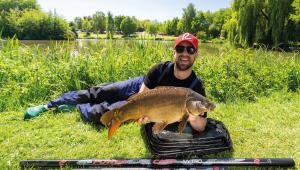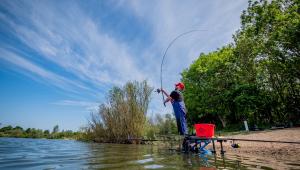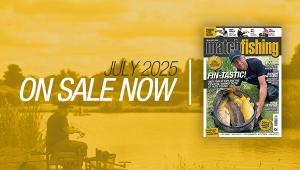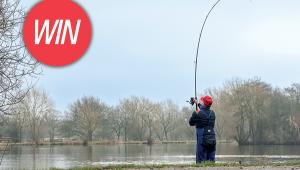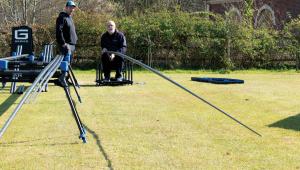Working At The Waggler…

Who better to join for a lesson in flowing-water waggler fishing than Garbolino’s river connoisseur and Welsh international, Lee Edwards?
When you’re sat biteless during a match on a river, there are probably hundreds of quality fish in front of you. It’s a bold and crazy statement to make, but one that I strongly believe in. The venue where we’re fishing today, the Warwickshire Avon at Evesham, is a perfect example. Three big matches pressure the 87-peg match length here most weeks, and the fish are incredibly wary. However, most of the pegs are teeming with fish all the time.
As soon as you get any colour in the water here, or during an evening, you catch all kinds of fish that you never see during matches. Great big roach, quality dace and chub, and species like bream, skimmers and hybrids suddenly appear.
Conversely, during bright daylight and in clear water, there is a very fine line between catching a match-winning bag and catching virtually nothing at all. You have to nurture the swim with a considered feeding pattern, incorporate finesse into your approach, and have patience to persevere until the fish can’t help but begin to feed.
When To Waggle
For me, the waggler is one of the most reliable methods of catching fish on rivers at this time of year. I normally choose to fish the waggler when I’m targeting a variety of species that are out of reach with the pole. Now, this doesn’t necessarily mean too far out to catch with a pole, it may mean that the fish are too far downstream to target properly on the pole, or even too spread out to target on the pole.
The waggler really allows you to search your swim, and in clear water wary fish move about a lot! One minute they may be picking up an odd maggot right at the bottom of your swim on the deck, while the next minute they could be two feet deep, guzzling the feed as it hits the water right at the top of the swim.
In clear water, the fact that there’s not a pole over the water to spook the fish is a big advantage too.

A regular feeding pattern with just six to eight maggots every time is aimed at pulling fish upstream and on to the line you’re fishing.
Watercraft Secrets
It can be very difficult to decide where to cast and fish. As a general rule, and on a low, clear river, I like to fish where the main flow is. You can normally see a certain line in the river where the water is flowing faster than everywhere else. Often, you’ll see some debris, bits of weed or even scummy bubbles on this line.
Today, however, this desired area of the swim is three-quarters of the way across the river, and I’ll struggle to loose feed maggots there accurately. Around halfway across the river, however, there is still plenty of flow, and I’ve seen an odd small fish topping. Here, I’ll be able to feed my bait accurately and hopefully feed some fish into the area from a little further out. It also leaves me with the option of venturing further out later if I need to.

If you’re coming back with bait like this, try casting further downstream to find bigger fish.
A Finesse Setup
I see many anglers treat the waggler as a one-rod attack that they simply try at some point during the match. For me, it’s much more than that, and if I draw a peg where I think it could work, I’ll fish it for the duration.
I’ve assembled two rods for it today – both 13ft Garbolino G-System light waggler rods. It’s very important that you use a soft rod with a tip action. This kind of rod allows you to fish with light hooklengths and small hooks without breaking off or pulling the hook out of fish. The tip action also means you can pick up line quickly on the strike – very important when you’re running a waggler down the middle of the river.
Both my rods feature a very fine main line – just 0.14mm Drennan Floatfish. This makes casting a light waggler easy, and the thinner line helps to avoid any skim or wind, giving you lots of control of your line and float.
The first rod is used for fishing shallow, while the other is for on or just off the bottom. I always set up two different rods, because I like to fish much lighter on the shallow rod, which features a 2.5g loaded peacock insert waggler. I’m starting with this set just three-and-a-half feet deep with four No4 locking shot around the float, and two No11s spaced evenly down the line. I’m only going to use a single maggot hook bait on this rod, so I don’t have a swivel down the line, and attach my 0.09mm hooklength to the main line with a neat loop-to-loop connection.
The second rig is for fishing on or near to the bottom, and features a slightly heavier 3g float of the same kind with the same locking shot. However, down the line I have seven No10 shot strung out evenly from the float all the way down the rig to the hooklength connection, which is done using a tiny size 24 swivel that acts as my last dropper. I’ll often use double maggot on this rig for fishing near the deck, so the swivel is essential.
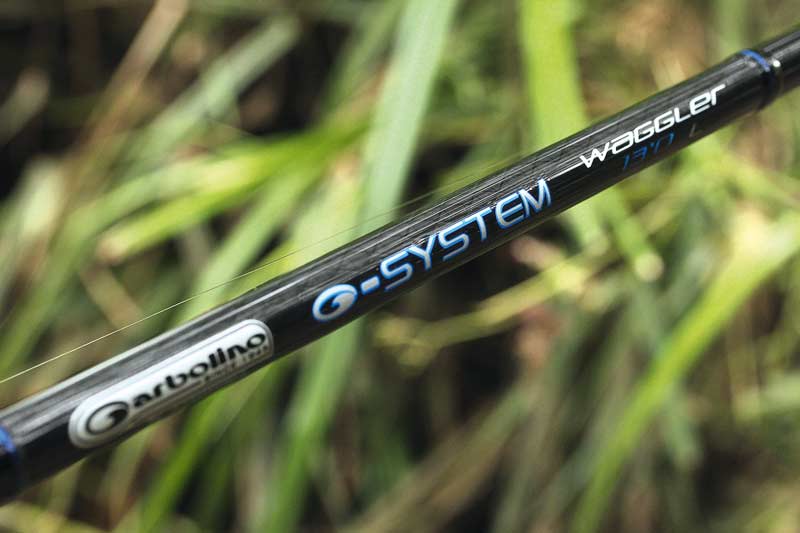
A soft, tip-actioned rod is Lee’s river waggler choice.
Adapt Your Wagglers
You may notice that I’ve adapted the tips or inserts of my wagglers. I do this for a simple reason – I can’t see solid cane or peacock tips very well. A plastic bristle lets light through, and glows like a beacon. I glue a thin hollow plastic bristle into my wagglers for fishing shallow, so these are very sensitive. There is no worry of this float dragging under from line dragging the bottom so I like a nice sensitive tip.
On the floats for fishing on the bottom I’ve inserted some thicker plastic tips. These remain visible, but will be resilient to dragging under if I need to pull a little line along the deck.
Starting A Match
I never like to rush into the match when fishing the waggler. Instead, I simply sit and feed for a few minutes. For all I know, there could be two or three quality fish there already, and if I was to cast straight in I could catch one immediately, which could totally spook the swim for the rest of the session.
My aim is to get a small stream of feed in the water, almost like a little trail that the fish can follow upstream, that will get fish in the area feeding. Another important point is to make sure that the most upstream point you feed is still always slightly downstream. If fish come right up on to the feed, this will give you plenty of scope to cast out and get the float running through before it reaches the fish. I also like to feed some maggots downstream in a couple of places. This bait will hopefully pull more fish upstream and into the swim, where they will settle into feeding on the main trail of feed. It’s a little bit like creating a chum trail for sharks!
When thinking about feeding amounts, I like to start by erring on the side of caution. Just six to eight maggots in each feed is my choice to start with. I want to gradually build up the swim and catch what is there to begin with.
If I were to start blasting large amounts in at the start of a session, any greedy fish such as perch and chub would fill up fast. Moreover, wary fish like roach and dace can shy away from sudden amounts of feed. I’ve watched species like this feeding in clear water before, and when you suddenly introduce a lot of bait from nowhere, they often swim away from the area!
By introducing small, regular amounts, fish are more inclined to compete for the feed. Ideally, I want the fish like bleak and small dace near the surface to start eating the bait first. These will in turn attract the attention of bigger fish, and hopefully induce them to feed. If I wanted to feed more, I’d rather step up the regularity than the amount of maggots that I put in my pouch every time.
Running The Float Through…
After feeding around a dozen times, I cast out just past where my feed is landing. This gives me the option to draw my bait back into the feed. If I miss a bite, I can release the float again and let it carry on running down the swim, not wasting time reeling in and casting again.
After casting in, I feed just in front of my float, and after a few seconds mend the line by lifting the rod and quickly flicking the line upstream; this helps to keep the line tight to the float, in turn enabling the float to run down the swim in a natural straight line, and giving me direct contact with the float to hit bites.
My bail arm is off all the time after casting, so that line can peel off the reel as the float moves downstream in the flow. The key here is to keep in touch with the line by gently touching the spool and feeling for the line peeling off, with the rod held in an easily manoeuvrable and strike-easy position over your knee. As soon as you think there’s line overtaking the float downstream in a bow, put the brakes on by placing your finger on the spool and mending the line again, before continuing to run the float through.

Lee starts the session on a bigger size 18 hook in case there’s an early bonus about.
On The Mend
A lot of small fish have homed straight in on the feed at the start of the session, with bleak, small dace and chublets coming to the net every cast. These fish are competing for the small and regular feed amounts.
A very efficient way to catch these fish is to hook them as you mend the line. Often, a fish will have your hook bait in its mouth but not pull your float under. When you mend the line, you will actually hook the fish and feel it, so you can then smoothly wind it in.
If there’s not a fish on as you mend the line, you simply run the float down another two yards, before mending it again. As you mend it, you’ll move the float and flick up the hook bait, giving it another fall and opportunity to catch a fish.
The Secret Swim
On any river with a little bit of depth close in, I like to feed a few maggots right on the end of my rod – just three or four every few minutes. Often, you can drop your shallower rig in here and catch an odd bonus fish. It’s a great line to drop on if you feel like you need to rest your main swim for five minutes.
Today, I haven’t even plumbed up here, and after a short quiet spell on my main line, dropping in off the rod end produces a run of eight chunky perch. I’ve probably put 2lb of fish in the net in 10 minutes! Moreover, it has given the main swim a short rest, and having fed it while not fishing it I cast back in and hook a bigger fish immediately, in the shape of a 12oz chub.
A Frenzy Column
As the session is progressing, the stamp of fish that I’m catching is getting bigger and bigger. While fishing on the bottom was good to start with, I’m catching better on the shallower rig set at four feet deep now. Holding the rod across my knee, I’m able to feed while running the float through.
I’ve also adapted my feeding slightly too. I’m now feeding three or four times every run down. This may sound rushed and hectic, but it really isn’t. I simply cast out, and feed in front of the float. As the float gets a short distance downstream, I feed again just in front of it and mend the line, pulling my float back into the feed so my hook bait is falling with this feed. I may repeat this process four times on a single run through, so my hook bait is falling with some feed at all points in the swim. This is exactly how I fished when I won the Evesham Championship on this river, with wary chub that were obviously only eating the feed falling through the water, and ignoring an unnatural looking single hook bait.

In low, clear river conditions, fish like dace, roach and chub will live in the main flow where the river is moving quickest.
A Strong Finish…
The small fish that I was catching at the start of the session have really thinned out now. Most of my bites are coming around three-quarters of the way down my swim. To speed up the process of getting bites, I’m now casting my waggler further downstream to start with, so that it settles into the area where these bigger fish are. I’m still feeding various times upstream of this too, to maintain the column of feed in the swim.
Several quality roach, numerous perch to 10oz, and half-a-dozen chunky chublets, the biggest pushing 1lb in weight, make for a very enjoyable end to what has been a brilliant session. It would have been easy to discard the waggler due to the intrusion of small fish at the start of a session, but by being accurate and consistent with the feeding I’ve ended with a stunning net of fish that would be more than enough to win most matches on this river.

Over 15lb of quality river fish by working hard at a method most anglers simply chuck and chance!
Angler File
Lee Edwards
Age: 40
Lives: Cardiff
Sponsors: Garbolino, Champion Feed
MF Says: A chunk of prime Welsh beef!
Venue File
The Warwickshire Avon
Location: Boat Lane, Evesham WR11 4BP
Contact: 01386 45460
Like what you see?
Or buy a single issue
- Log in or register to post comments



